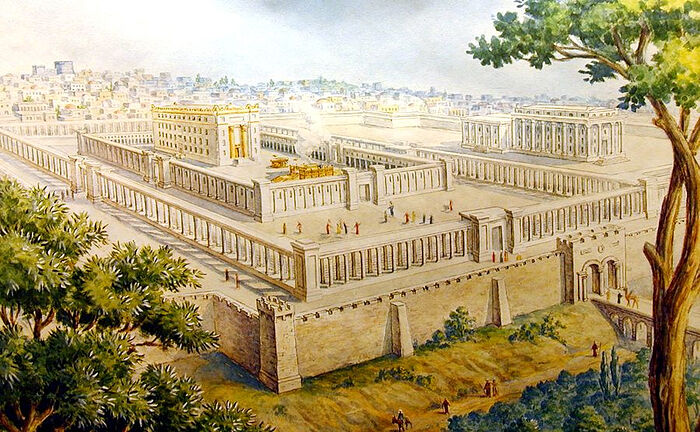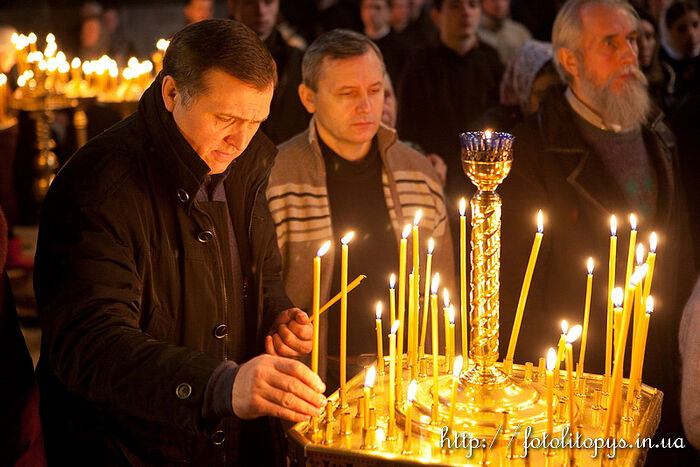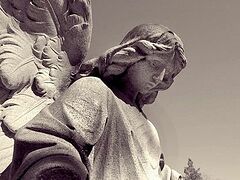The Bible is an historical book. It begins with the narrative of Moses about the creation of heaven and earth, and ends with these words of St John: “And I saw a new heaven and a new earth; for the first heaven and the first earth had passed away, and the sea was no more” (Rev 21.1). The paradise that was lost was a garden; the coming kingdom will be a city, “coming down out of heaven from God” (Rev 21.2). Man lost a garden, but he is to take up occupancy of this heavenly city. The entire history of mankind is one of progression from earth to heaven, from old to new. Between our lost bliss and the coming kingdom there is a huge difference. The former was a state of innocence; the latter will be a state of holiness. The former is characterized by inexperience, which implies danger; the latter by endurance, experience and, as a result, serenity. However, they both share a common feature: there is no temple.
In paradise there was no need of one, for the whole world was a temple. All the stars were the lamps, all the flowers were censers, and man’s task was to officiate amidst innocent beauty, praising God, singing spiritual songs, and gathering round himself all living beings. This is how it was at the beginning of history; but nor will there be a temple at its end. As John says, “I saw no temple in the city, for its temple is the Lord God the Almighty and the Lamb” (Rev 21.22).
Thus the temples of God—which is what our Christian churches are, so familiar and so necessary—did not come into being along with man.1 Nor will they be transferred from earth to heaven. However, it would be unforgivably flippant to doubt the necessity of such buildings here in this ongoing earthly reality, as we proceed on our way to our Father's house. A temple is not built in order to embrace God with walls, enclosing Him within. This was made clear during the construction in Jerusalem of the first temple in the world to be dedicated to the true God. As Solomon said at the time, in his Dedication Prayer, Behold, heaven and the heaven of heavens cannot contain Thee; how much less this house that I have built to Thy name? Yet have thou respect unto the prayer of thy servant ... That thine eyes may be open toward this house night and day, even toward the place whereof thou hast said, ‘My name shall be there,’ to hearken unto the prayer which thy servant shall pray ... [and] to the supplication ... of thy people Israel when they shall pray in this place (1 [3] Kings 8:27–29). Solomon then goes on to enumerate examples of specific occasions for which his people might require and obtain help, by praying in the temple (8:31–53). Thus a special place was established for communication between God and man, solely for this purpose. The temple was at the heart of religious life. Its destruction was a catastrophe. After the Israelites returned from captivity, the temple was the first thing that had to be restored, and things continued as before. This went on for centuries.
The words of the Saviour to the Samaritan woman at Jacob’s well—that to worship the Father it was not necessary to be either in Jerusalem or in Samaria, but that true worship is that which is performed “in spirit and truth”—could be perceived as subversion of temple piety. In fact, however, it is a prophecy to the effect that the glory of the Jerusalem temple would be transferred to any place where the Living God was worshipped. And that where such worship “in spirit and truth” took place, there would eventually arise numerous new sanctuaries, new temples, just as glorious as the ancient temple in Jerusalem.
While the temple itself stood, the apostles worshipped there. Nevertheless, the fact that “the Most High does not live in temples made by hands” (Acts 7. 48) was the very first thing that had to be made clear to the Gentiles. After all, the whole world was densely strewn with large and small temples in honour of false gods.
The Jerusalem temple continued to be a shrine in the eyes of those Jews who believed in Christ as well as those who did not. And this despite the fact that the veil which served as a barrier to the Holy of Holies was torn from top to bottom at the supreme moment of Christ’s self-sacrifice, pointing to the fact that grace had departed from it. Despite, also, the fact that the blood of the Son of God rendered pointless the blood of animals that was shed by the sacrifices. The apostles clearly believed that they could not abandon the temple until God Himself destroyed it again, this time through the hands of the Romans. Until that happened, “Peter and John [went up] together to the temple at the hour of prayer (Acts 3.1). Likewise, Paul, having observed the ceremonies of purification, went into the temple to present an offering (see Acts 21.26).
Soon the temple would indeed be destroyed, and on the same day as the first temple had been. Moreover, the Jews can have only one temple and only in a certain place that is specified by God. The whole Law is tied to temple rituals. Without sacrifice and religious services, it is in principle impossible to fulfil the Law. However, something mysterious happens. God had given the Law to one people only and had bound the fulfilling of this Law to the only possible temple, in the specified place. But then the Lord allows the destruction of this temple and takes His people into captivity, so that they would learn to remember God, to repent, and to pray without the rituals associated with the Law. Having done heavy penance, the people return and rebuild the temple. But now they also construct many synagogues, for these had been substitutes for the temple in the land of exile. Then this second temple too is destroyed. Not for seventy years this time, but right up until the final events of human history.
The people are scattered, the temple is in ruins, the law is impracticable, and it is forbidden to erect another temple in another place. Was this not a divine indication that the times of the Law had passed, and that the time has come for all nations to enter the family of God, repenting and believing in the Gospel? The glory that in ancient times belonged only to the Jews, now passes equally to all those who believe with all their heart in God and His Son Jesus Christ. Spiritual sight, moral purity, prophetic inspiration, feats of prayer, and treasures of spiritual books—all these spread to other nations and nationalities. The glory of the one Jewish temple also passes to the thousands of new sanctuaries in which the crucified and risen Messiah is sung.
So the one and only temple, that was formerly the heart of the chosen people, is destroyed. But in its very destruction it is fragmented and multiplied a thousandfold, now becoming the heart of every Christian village and every Christian city. In these temples, a new teaching is preached, according to which the person himself must be a temple. Do you not know that you are God’s temple and that God’s Spirit dwells in you? If anyone destroys God’s temple, God will destroy him. For God’s temple is holy, and that temple you are (1 Cor 3. 16–17).
Where does this new idea come from? From where does this unexpected perspective on man come, that he should become a God-bearer and a living temple? For heaven itself, as was said above, is powerless to contain God, and the Jerusalem temple did not pretend to do so. How, then, can man have any pretension to that which is impossible for the cosmos, let alone the many man-made sanctuaries?
It was Christ Himself who gave this new teaching. During his earthly life, acting with authority in the House of his Father, he said: Destroy this temple, and in three days I will raise it up (John 2. 19). The Jews could not understand Him, and interpreted these words as mockery or a daring challenge. But He was speaking of the temple of His body (John 2. 21).
Thus the true temple is the body of Christ, destroyed by suffering and crucifixion, but raised from the dead on the third day. Christ did not simply gladden the disciples by means of His resurrection. He also gave them to eat and drink of His body and blood, saying: “He who eats me will live because of m” (John 6.57). That is where this new teaching comes from. Christ is risen, and His body is the restored true temple. Christ gives believers communion with Himself in the Eucharist, and the communicants in their turn also become temples. The temples, the churches, which were erected in large numbers by Christians—whether in stone or wood, whether richly adorned or humble—mainly serve to celebrate the Eucharist.
Our temples, our churches, are not synagogues; they are not places of assembly where the law is read, psalms are sung, and sermons given. They are, first of all, places for unity with Christ through communion. And in this capacity they will be needed until the second coming since, as Paul tells us, the liturgy itself is to be celebrated until He comes (1 Cor 11.26).
Where there is no understanding of the Eucharistic nature of the Church, where the place of congregation is similar to a synagogue—that is, with singing, reading and preaching—there they select quotations from Scripture that reject the idea of a temple. There they are in a hurry to portray things as if the Kingdom had already come, that there is no more death, that all tears are wiped away, and that the very gates of our towns are the “pearly gates”. But this is a false haste, the fruit of a deliberately induced state of excitement. In fact, the journey continues, and the goal has not yet been achieved. We still hope to be saved, but we walk by faith, not by sight (2 Cor 5.7).
In those cultures where the places of Christian worship are built as concert halls, the crux of the matter lies not in their aesthetic preferences or architectural taste. These are merely visible manifestations of the underlying Eucharistic crisis and the deviation from grace into the realms of religious fantasy. Furthermore, the legalization of bodily corruption—that is, a tolerant attitude towards the destruction of the temple of God that is the human body (cf. 1 Cor 3.17)—arose precisely in those places where the Christian temples took the form of concert halls.
Conversely, it is touching to learn that our Orthodox communities in Western countries are often generously offered empty churches for services. These are not like concert halls, but are ancient and new temples that were built for the administration of the sacraments. In some of them there are a few parishioners, in others none at all. They are given with love for the celebration of the Eucharist to people whose grandfathers destroyed the churches in their homeland and who have now come to earn a penny in faraway lands. These poor emigrants, as it turns out, can also somehow enrich the countries of their temporary residence. Under the vaults of desolate, sad churches, they bring with them the spirit of the ancient apostolic faith and Eucharistic Sunday joy. It is amazing! These churches lost parishioners not as a result of persecution but indifference and the toxic spirit of worldly temptations. Who would have thought that people from countries that were recently characterised by militant atheism would come to these places in order to light candles on Sundays? The journey continues. The people eat manna as before. And it is for the sake of food, for the sake of heavenly bread, that we need temples, whether restored or newly built. In them, thanks to communion, repentance and prayer, people are meant to turn themselves into what Paul calls living temples. Or as Peter says, echoing him, “like living stones be yourselves built into a spiritual house, to be a holy priesthood, to offer spiritual sacrifices acceptable to God through Jesus Christ” (1 Peter 2. 5).






